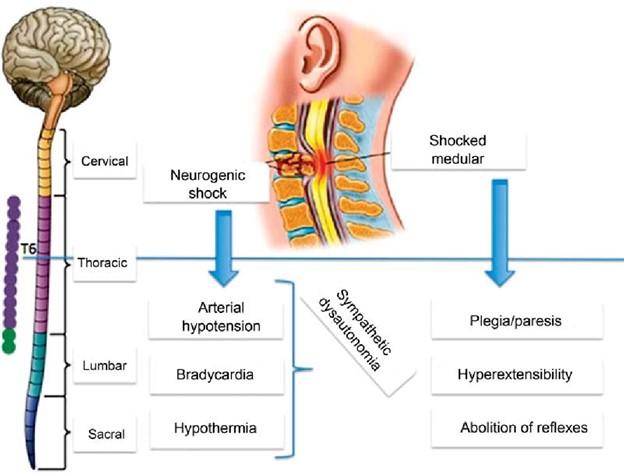A client arrives to the emergency department after falling from a ladder. The client has a loss of sensation and flaccid paralysis. Which of the following complications of an acute spinal cord injury does the nurse suspect?
Hemorrhage
Spinal shock
Apoptosis
Neurogenic shock
The Correct Answer is B
Choice A Reason: Hemorrhage is not a complication of an acute spinal cord injury, but rather a possible cause of it. Hemorrhage can occur due to trauma or rupture of blood vessels in or around the spinal cord, leading to compression and damage of the nerve tissue.
Choice B Reason: This is the correct choice. Spinal shock is a complication of an acute spinal cord injury that occurs within minutes to hours after the injury. It is characterized by loss of sensation, motor function, reflexes, and autonomic function below the level of injury. It is caused by transient disruption of nerve conduction and synaptic transmission in the spinal cord.
Choice C Reason: Apoptosis is not a complication of an acute spinal cord injury, but rather a cellular process that occurs after it. Apoptosis is programmed cell death that occurs in response to injury or stress. It can lead to further loss of neurons and glial cells in the spinal cord over time.
Choice D Reason: Neurogenic shock is a complication of an acute spinal cord injury that occurs within hours to days after the injury. It is characterized by hypotension, bradycardia, and peripheral vasodilation due to loss of sympathetic tone and unopposed parasympathetic activity. It is caused by disruption of autonomic pathways in the spinal cord.

Nursing Test Bank
Naxlex Comprehensive Predictor Exams
Related Questions
Correct Answer is D
Explanation
Choice A Reason: This choice is incorrect. Losing bladder control is not a feature of complex partial seizures, but rather of generalized tonic-clonic seizures. Complex partial seizures are a type of focal seizures that affect a specific area of the brain and cause impaired awareness and automatisms. Automatisms are repetitive and involuntary movements or behaviors that occur during a seizure.
Choice B Reason: This choice is incorrect. Having fixed and dilated eyes is not a feature of complex partial seizures, but rather of brain death or severe brain injury. Complex partial seizures do not affect the pupils or eye movements, but rather the level of consciousness and motor activity.
Choice C Reason: This choice is incorrect. Making involuntary groaning sounds is not a feature of complex partial seizures, but rather of simple partial seizures. Simple partial seizures are a type of focal seizures that affect a specific area of the brain and do not impair awareness or cause automatisms. They can cause sensory, motor, or psychic symptoms, such as auditory or visual hallucinations, tingling sensations, or emotional changes.
Choice D Reason: This is the correct choice. Having involuntary facial movements, such as lip-smacking, is a feature of complex partial seizures. Complex partial seizures often originate from the temporal lobe of the brain, which is involved in memory, language, and emotion. They can cause automatisms that affect the mouth, face, or hands, such as chewing, swallowing, picking, or fidgeting.
Correct Answer is B
Explanation
Choice A Reason: Hemorrhage is not a complication of an acute spinal cord injury, but rather a possible cause of it. Hemorrhage can occur due to trauma or rupture of blood vessels in or around the spinal cord, leading to compression and damage of the nerve tissue.
Choice B Reason: This is the correct choice. Spinal shock is a complication of an acute spinal cord injury that occurs within minutes to hours after the injury. It is characterized by loss of sensation, motor function, reflexes, and autonomic function below the level of injury. It is caused by transient disruption of nerve conduction and synaptic transmission in the spinal cord.
Choice C Reason: Apoptosis is not a complication of an acute spinal cord injury, but rather a cellular process that occurs after it. Apoptosis is programmed cell death that occurs in response to injury or stress. It can lead to further loss of neurons and glial cells in the spinal cord over time.
Choice D Reason: Neurogenic shock is a complication of an acute spinal cord injury that occurs within hours to days after the injury. It is characterized by hypotension, bradycardia, and peripheral vasodilation due to loss of sympathetic tone and unopposed parasympathetic activity. It is caused by disruption of autonomic pathways in the spinal cord.
Whether you are a student looking to ace your exams or a practicing nurse seeking to enhance your expertise , our nursing education contents will empower you with the confidence and competence to make a difference in the lives of patients and become a respected leader in the healthcare field.
Visit Naxlex, invest in your future and unlock endless possibilities with our unparalleled nursing education contents today
Report Wrong Answer on the Current Question
Do you disagree with the answer? If yes, what is your expected answer? Explain.
Kindly be descriptive with the issue you are facing.
